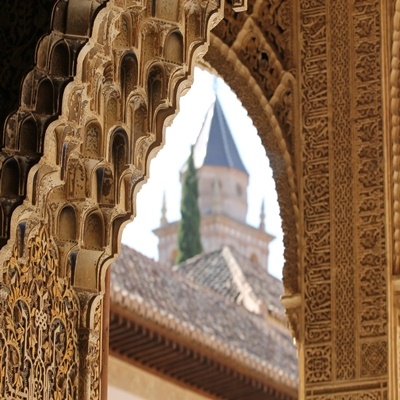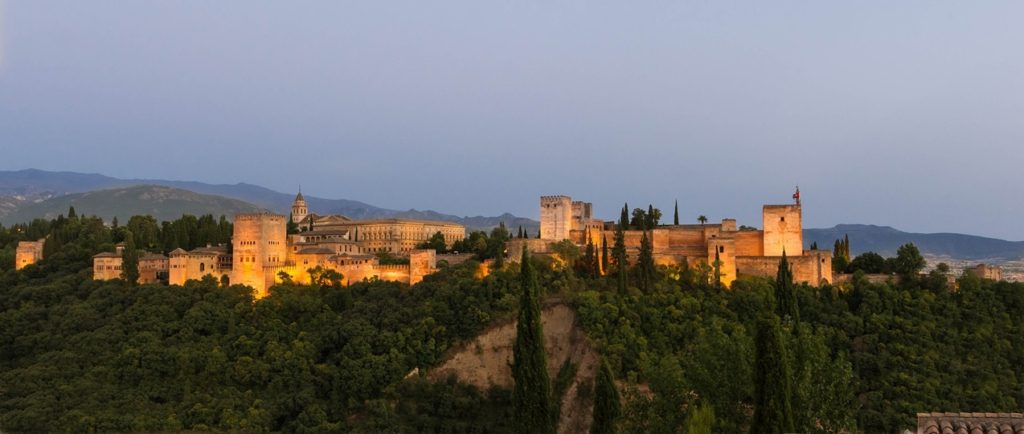
The Alhambra of Granada at night • Travel Granada Alhambra
History and nature have painted a picture at the foothills of the Sierra Nevada that will have you sink down to your knees and pray that you may never wake up again from this wondrous dream! Granada and the Alhambra form a timeless space that sends echoes of natural beauty out into eternity. The best way to enjoy this unique place is to live in the moment or what is called the Art of Now.
Walk around the surrounding umbrageous woods and valleys with their magnificent gall-oak trees, evergreens, elms and pinsapo pines.
Allow yourself the time to meditate on the melancholic quality of the graded shades and silhouettes of the rugged mountain peaks of the Sierra Nevada that loom in the background.
Immerse in the spirit of vibrancy as the site is filled with life by singing birds and the omnipresent life-giving water that trickles through the symmetrical canals like the blood that is pulsating through your veins.
And marvel at the dramatic Moorish architecture that has survived the test of time and war: The arched Arabian windows, the superb latticework, the intricate reliefs and arabesques of the palaces and the refined garden structures and myrtle hedges that recall the time when you were hiding with Alice in the mazes of the Wonderland.
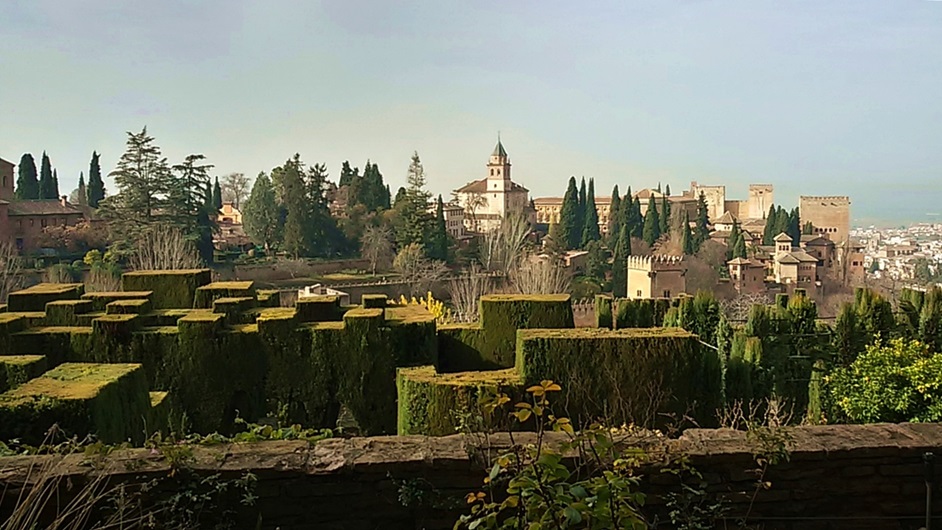
Hiding with Alice in the mazes of the Generalife gardens • In the center the Church of Santa Maria de la Alhambra • At the right the Alcazaba (the military fortress) • Travel Granada Alhambra
1. Tips for buying a ticket
More than 2.4 million guests visit the Alhambra of Granada every year, making it one of the most visited touristic sights in the world. Due to the confined space within the compounds of the palaces, tickets per day are limited. Therefore you will be well advised to reserve a ticket for your visit to the Alhambra in advance. Otherwise you might end up in front of the entrance gate not being allowed in.
Navigating the official Alhambra Ticket Master Website is tricky and collecting the tickets is even trickier. You might also ask yourself what type of ticket you should buy. And how can you make sure that you get access to all areas? Don’t you worry! When you follow our step-by-step tips you will have no problem securing those precious tickets. And even better: We will also tell you how you can still buy tickets if the official Ticket Master Website is already sold out on a specific date. Click here for the tips!
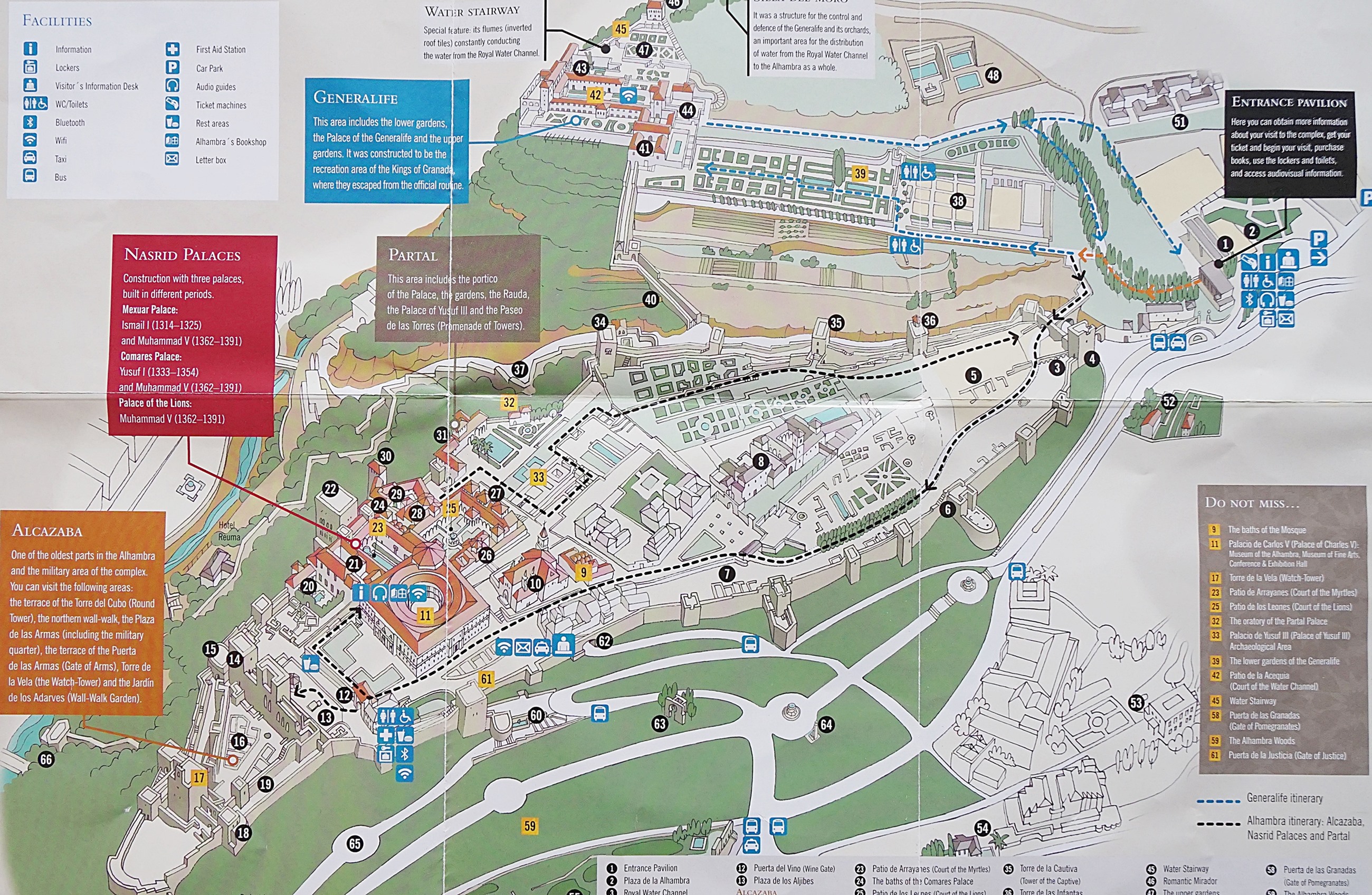
Detailed, zoomable map of the Alhambra • Zoom in/out with the +/- buttons • Travel Granada Alhambra

Legend of map • Travel Granada Alhambra
2. The different areas of the Alhambra
a) The Generalife
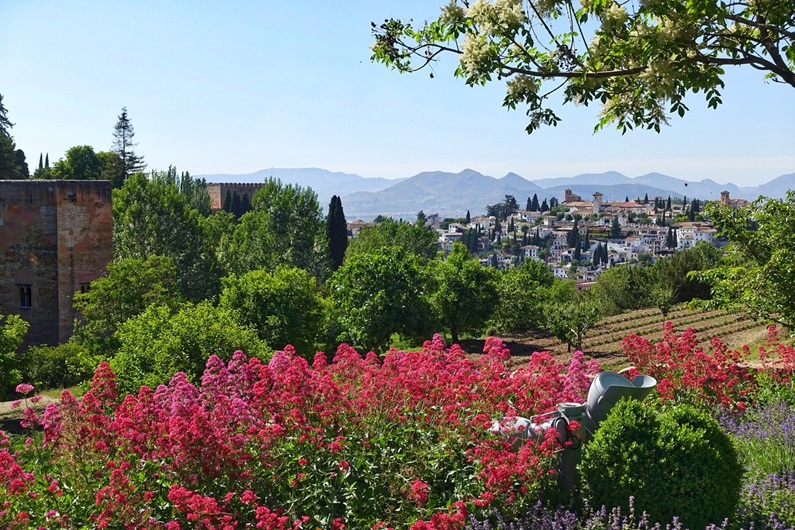
The lush vegetation of the Generalife Gardens – the Garden of Paradise • Travel Granada Alhambra
If your allocated time slot to the Nasrid Palaces allows, you should start your exploration of the Alhambra at the Generalife Gardens. As you can see on the map, you should keep slightly to your right after you enter the main gate and enter the lower gardens of the Generalife at point 39.
“Generalife” could be translated as “Garden of Paradise” or “The Architect’s Garden“. When you enter the gardens you will immediately understand why. The design is sophisticated, with imposing cypress walls and arched rose gardens majestically dominating the landscape. You can also spot the occasional orange and almond trees through the openings of the maze-like, towering cypress hedges that make you feel like you are walking along architectural battlements of plants. Promenading through the lush colonnades, overhung with ivy and dotted with pastel colored flowers of marigold, lilacs and lantana, you feel refreshed and cool, even on a scorching summer day.
This is what the Sultans of the Alhambra had in mind when they had the gardens and the Palace of the Generalife built in the 13th century. Here they could flee the heat and the turmoils of everyday political affairs to refresh the mind and replenish body and the spirit. In particular the elaborate arrangement of water fountains and water flowing through little canals and water channels throughout the entire Generalife complex adds immensely to the sensation of having entered a otherworldly realm of relaxation.
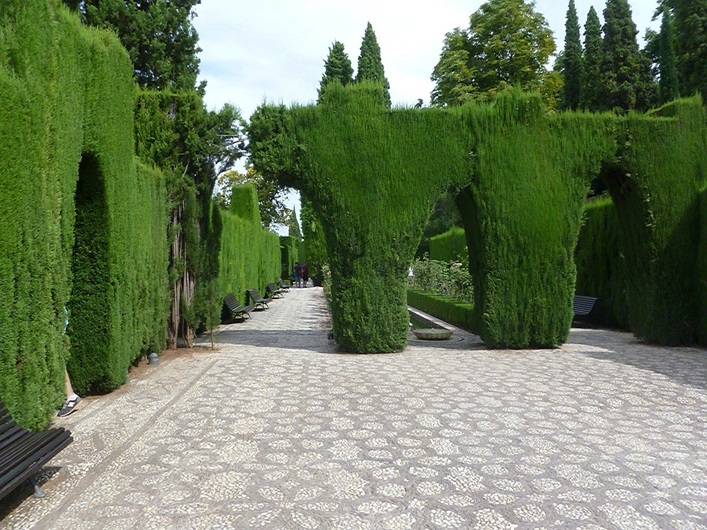
Plant-based battlements at the Generalife • Travel Granada Alhambra
The Muslim rulers of the Alhambra appreciated the virtues of total seclusion and they constructed the inner area of the Generalife retreat accordingly. After having passed the extensive lower gardens, visitors reached the Patio de Descabalgamieno – the Court for Dismounting (Point 41). Here the noble folks got off their horses and servants took over the horses and brought them to their stables. The guests then entered the inner circle of the Generalife by being lead to the enclosed Patio de la Acequia – the Court of the Water channel.
The Court of the Water Channel is the most significant point of the Generalife Palace. The symmetrical outline of the courtyard is in line with the general Muslim ideal of symmetrical patterns that can be seen throughout the Alhambra. The water channel divides the courtyard into two halves and is surrounded by myrtle bushes, cypresses, rose bushes and lilacs. The court is flanked on the western side by a portico with 18 ogival arches. Straight ahead following the flow of the water is the northern pavilion with its simple white facade. The buildings of the Generalife Palace in general are much less grandiose and far simpler than the Nasrid Palaces in the center of the Alhambra. This is by design, as the Generalife Retreat had not been built for representative purposes, but exclusively for the sultans to rest their weary bodies.
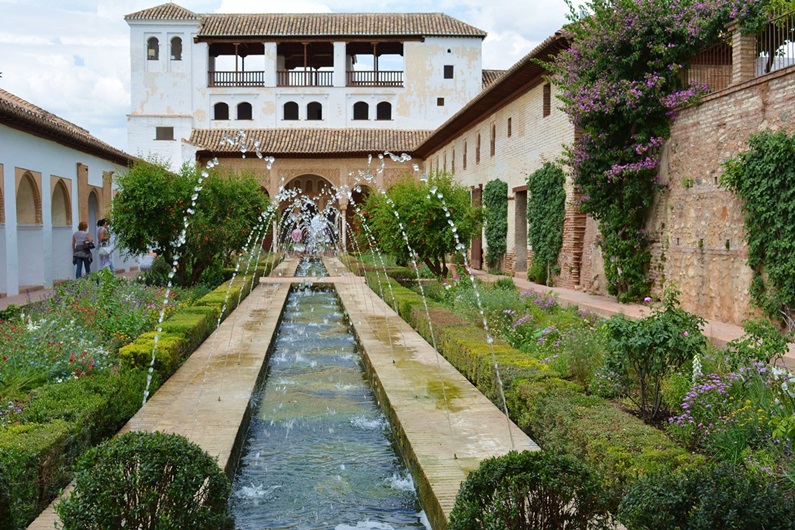
The Court of the Water Channel at the Generalife • Travel Granada Alhambra
Walking through the arched entrance of the northern pavilion and turning right leads us to another patio called Court of the Sultana (point 43), which eventually leads us to the upper gardens (point 47) and the Water Stairway (point 45). The water stairway is of particular beauty. It is divided into three plateaus each of which has a fountain. As you climb towards the highest point of the Generalife, the water is constantly surrounding you because the water flows through the earthen handrails left and right of the staircase.
The Generalife Gardens overlook the prominent medieval towers and battlements of the Alcazaba to the west. Keep your camera ready for stunning views of the area as the Alcazaba rises dramatically on the opposite hill.
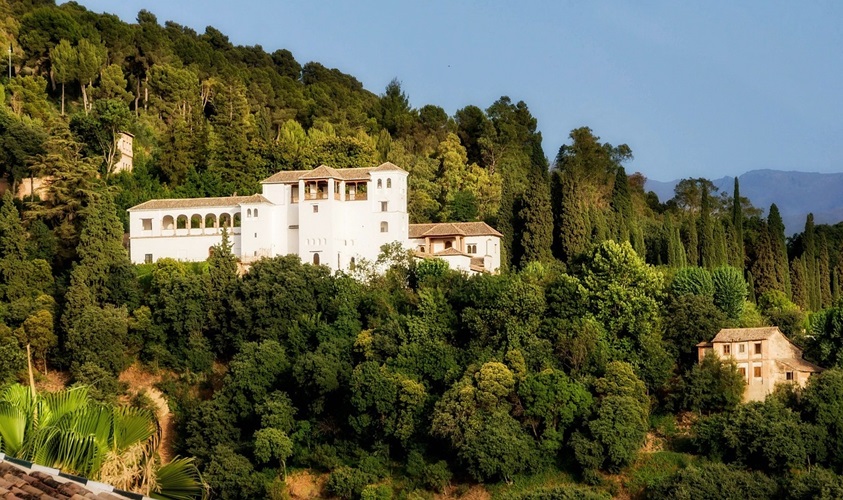
The unostentatious Generalife Palace comes without a lot of ornaments and embellishments • Travel Granada Alhambra
b) The Alcazaba
Walk towards the Alcazaba by following the medieval wall on the Southern side of the Alhambra past the Seven-Storeyed Gate (point 6) and the ancient Arab baths (point 9) built by Emir Muhammad III. The baths as well as the adjacent Church of Santa Maria de la Alhambra (point 10) are worth a quick stop if you have the time, however there are greater sights awaiting. So if you are in a bit of hurry you might skip this part. The church was commissioned by the Catholic monarchs King Ferdinand and Queen Isabela, after the Christian troops had reconquered the Alhambra from the Muslim sultans in 1492. The mosque which had been standing on the grounds since the beginning of the 14th century was torn down to make space for the Catholic church. Only the Moorish baths remained of the former Muslim complex. Thus are the ways of religious ideologies.
Continue your walk straight on, leaving the Palacio de Carlos V (point 11) on your right, and enter the Alcazaba at the Wine Gate (point 12).The Alcazaba sits at the Western most point of the Alhambra and as the thick walls and watchtowers already indicate used to be the fortress of the Alhambra from which the Moors defended the royal residence against foreign troops. This is the oldest part of the Alhambra, some parts of which date back to as early as the 9th century. It is in this military complex that all Moorish troops were garrisoned.
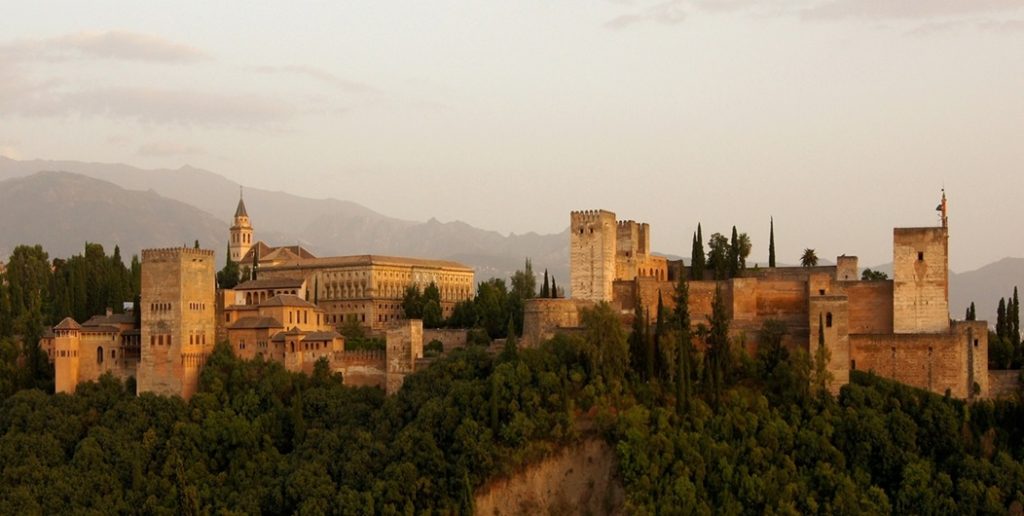
The Alcazaba of the Alhambra • Torre de la Vela with the bell on top at the far right of the picture • Travel Granada Alhambra
At the Plaza de Armas – the Square of Arms (point 16) – one can still see the remains of the military quarters where the Moorish troops used to live. The Square of Arms also served as an open space for military parades. As can be expected the Moors also created a vast network of underground tunnels and dungeons at the Alcazaba. The tunnels served as secret passageways to bring in fresh supplies of water and food in the case of a siege, and to move around troops secretly. The dungeons, on the other hand, allow a glimpse into the darker side of the Alhambra as they whisper about tales of grisly torture and the agony of medieval imprisonment. You can sneak a peak of one of the dungeons close to the Torre Quebrada – The Broken Tower in the north east (without number, next to number 14, basically right at the entrance).
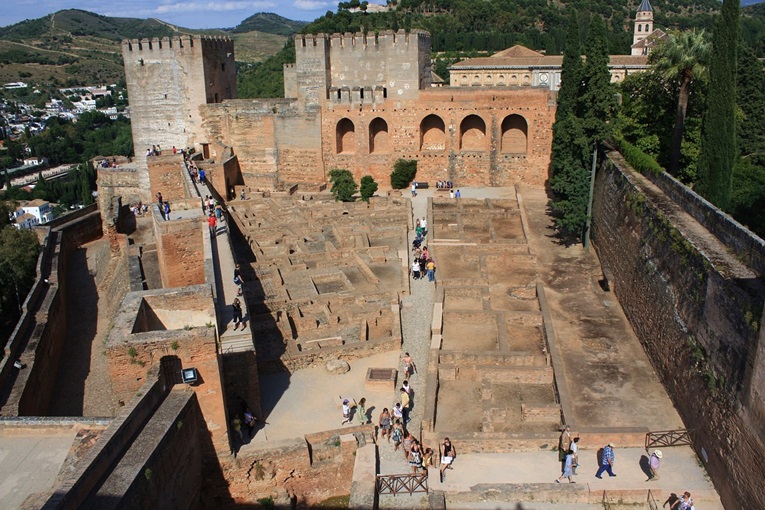
Plaza de Armas – Ruinous remains of the military quarters • Travel Granada Alhambra
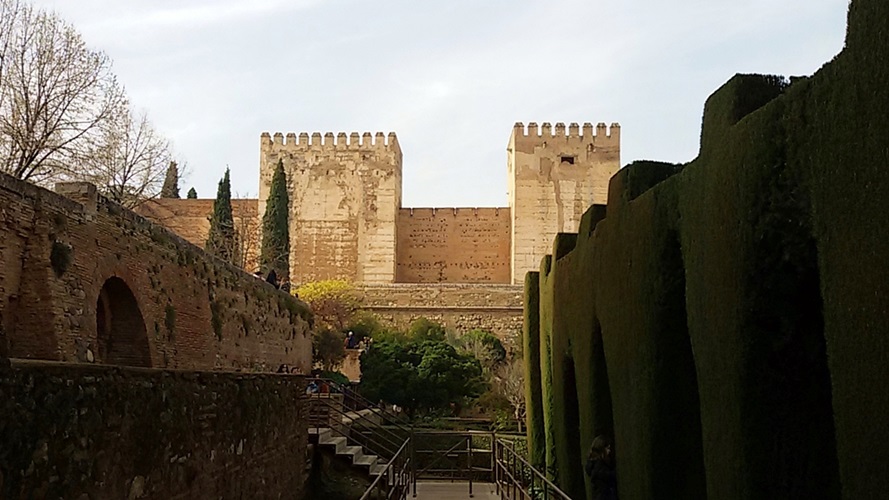
The towers of the Alcazaba as seen from the Patio de Machuca • Travel Granada Alhambra
From among the mighty ramparts of the Alcazaba rise several formidable towers. The afore-mentioned Broken Tower, the Keep (Torre Homenaje – point 14), the Round Tower (Torre del Cubo – point 15), the Gunpowder Tower (Torre de la Polvora – point 18) and the Watchtower (Torre de la Vela – point 17).
The Torre de la Vela is the most magnificent of the many towers. At an elevation of 26,80 meters you can enjoy a stunning view over the ancient neighborhood of the Albayzin to the north, with its winding alleyways and picturesque little houses.The bell at the top of the tower used to inform the citizens of imminent danger, as well as announce the time when the farmers should water their fields at night. Today the bell is merely the center of a little adoring anecdote: Spanish legends suggest that if a young woman strikes the bell, she shall get married before the year is over. So ladies, if you are waiting for your Prince Charming to make a move, strike the bell and let fate and Spanish traditions take care of the rest 😉
c) The Nasrid Palaces
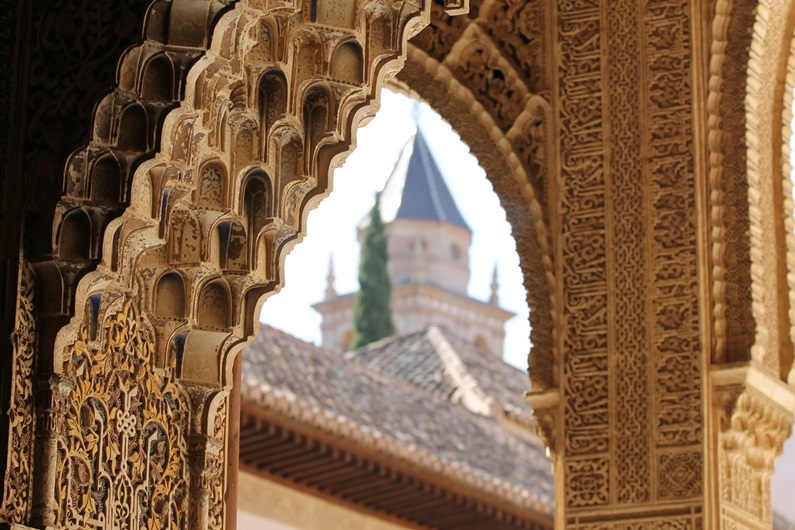
The Nasrid Palaces are rich in ornaments and calligraphic writings • Travel Granada Alhambra
The last Muslim dynasty that ruled the Emirate of Granada was the Nasrid dynasty. The Nasrid rulers were in power in Granada from 1238 until the fall of the Alhambra in 1492. It was during this period of opulence that the most magnificent and grandiose parts of the Alhambra were built – the Nasrid Palaces. There are essentially three palaces that are part of this complex: The Mexuar Palace built during Isma’il I’s rule (1314-1325), the Comares Palace the construction of which is attributed to Yusuf I (1333-1354), and the Palace of the Lions which was the palace of Muhammad V (1362-1391).
Each of the palaces had a different function. While the Mexuar Palace formed the public reception hall in which topics of politics, state administration and justice were dealt with, the Comares Palace was the official residence of the Sultan. It is in the Comares Palace that the sultan and his four wives and many children had their bedchambers and private rooms. The Palace of the Lions was the most private area within the complex and it is here that the Nasrid sultans had their harem, to which only the sultan’s wives, concubines and the eunuchs had access.
In order to enter the Nasrid Palaces compound you have to go through the Patio de Machuca (point 20) which is just a stone’s throw away from the Alcazaba. The court leads you directly to the rooms of the Mexuar. In the wide conference hall that you will enter the ministers and advisors of the sultan met to discuss matters of politics and the sultan also received here visitors in official audiences. The adjacent oratory served as a prayer grounds for the Muslim rulers, where the members of the royal family and ministers would gather for their daily prayers.
While the decorations and ornaments in the Mexuar Palace are far less spectacular than what is about to come when you visit the other two palaces, it is nonetheless interesting to take note of the tessellated tile patterns on the walls of the conference hall. The intricate geometrical arrangements sparked the interest of Dutch artist MC Escher during his many visits of the Alhambra. Inspired by the artistry of the Muslim architecture, Escher would go on to replicate the endless repetitions of the tessellations in many of his own artworks. He thus added this hypnotic dimension and optical illusion to his art that we all so admire.
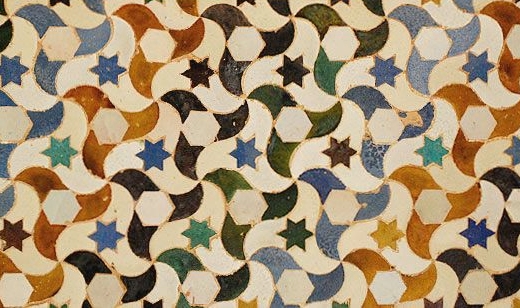
Tessellated tile patterns at the Mexuar Palace • Travel Granada Alhambra
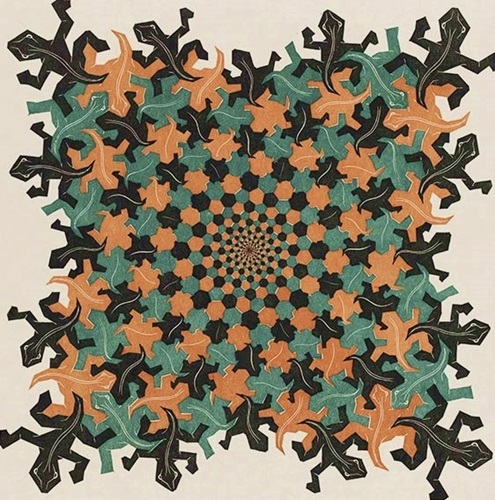
Alhambra-inspired salamander tessellation art by MC Escher on display at the “MC Escher In Het Palais” museum in The Hague • Travel Granada Alhambra
When you continue with your tour you will next reach the Palace of Comares via the Patio del Cuarto Dorado which connects the two palaces. Yusuf I, who had this palace built during his reign, wanted to dazzle visitors of his residence with the sheer grandeur of its decorations and designs and he certainly fully succeeded in this respect. At the center of the Comares Palace lies the tranquil Patio de Arrayanes – the Court of the Myrtles. The stunning courtyard has received its name from the hedges of myrtle bushes which flank the central pond. An impression of utter serenity is evoked as you stand in awe overlooking the northern gallery and the Tower of Comares which is reflected in perfect harmony in the oblong pond.
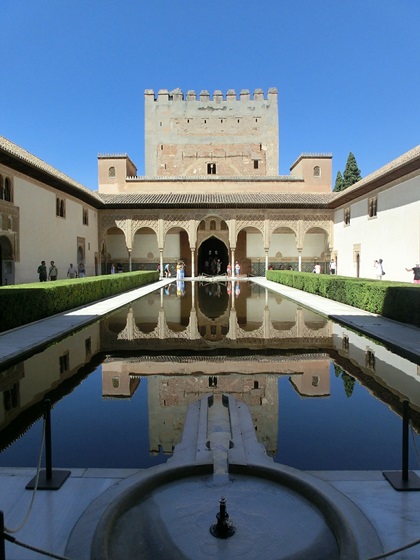
The Court of the Myrtles • Travel Granada Alhambra
The name Tower of Comares derives from the Arabic word camariyya which refers to the colorful stained glass windows that used to adorn the tower. Alas the windows were destroyed as a result of an explosion in the nearby powder house in the 16th century and never got replaced. With a height of 45 meters the tower is the largest of the Alhambra.
Several beautiful rooms frame the Court of the Myrtles, of which the Hall of the Ambassadors is the most majestic. The breath-taking 18 meters high ceiling in this hall seems to be reaching right for the firmament of the world. The entire structure of the ceiling consists of thousands of small polygonal pieces of cedar wood. These form an intricate cosmos of stars and constellations which represent the Seven Heavens of Paradise in the religion of Islam. The exquisite carved stucco work that covers all four walls of this hall delineates a series of poems and scriptures that narrate the greatness of Allah.
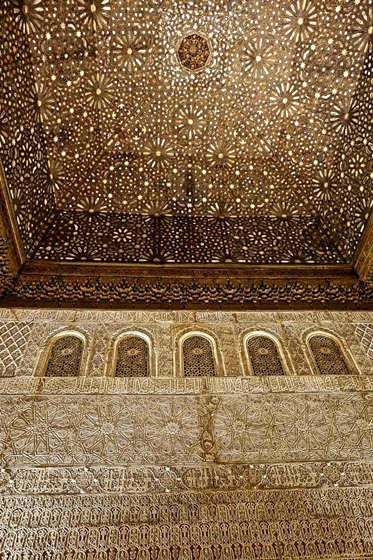
The Ceiling of the Seven Heavens of Paradise at the Hall of the Ambassadors • Travel Granada Alhambra
In the northern part of the Comares Palace we also find the Sala de la Barca – the Room of the Boat. This elliptic shaped room served the sultans as an anteroom in which visitors had to wait to be received. There are two explanations how this charming hall received its rather strange name. One is that the Spanish conquistadores simply mistranslated the Arabic name of the room “baraka” (which stands for blessing) by using the similar sounding Spanish word “barca” (which means boat). The other explanation is that the shape of the wooden ceiling resembles the shape of a boat seen from below.
A narrow crooked passageway, adorned by the architectural splendor of arabesque stucco work and honeycomb-like pillars and archways, guides us towards the Palace of the Lions. Mohammad V, Yusuf I’s son, took the art of royal construction here to new levels and cemented his own legacy through this monumental ode to beauty. At the center of the palace lies the Courtyard of the Lions from which branch off a series of glorious halls.
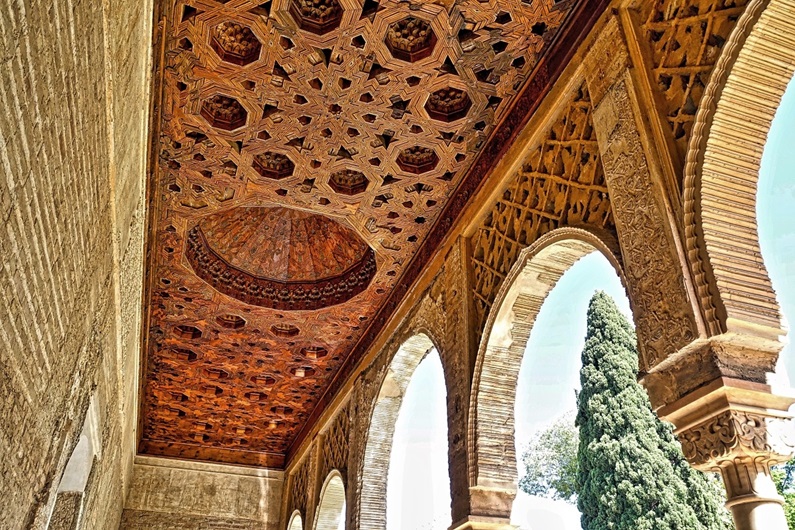
Even the narrow passageways of the Alhambra are rather spectacular • Travel Granada Alhambra
Visitors enter the Courtyard of the Lions via the Hall of the Mocarabes, which is exactly the way how personal visitors and friends to the royal family would have entered back in the days of the sultans and emirs. As is they way of kings and sultans of course, they would make you wait before you could see them, even if you were a friend – and wait for a long time you would in order to establish the right balance of power between sultan and subjects. The Hall of the Mocarabes formed the vestibule or waiting area to this most private area of the palace and after you had stood forever and a day (because of course there would be no seating) you would feel very uncomfortable. It’s the kind of games that the powerful play with you just to make sure that you know your place in the world.
The Courtyard of the Lions is the most storied place of the Alhambra. In the middle is the mysterious water basin carried by 12 water spitting marble lions. From the fountain spread out small water runlets, which guide water towards each cardinal direction which results in an intricate irrigation system that offers a cooling effect for the entire patio. The faceless lions are evidently not Arab in style, as Muslims were not allowed to portray living creatures in any form.
It becomes clear here that the rulers of the Alhambra had undoubtedly been influenced by the Western world, as is substantiated by the close friendship that Mohammad V and the Christian king Pedro I maintained. The Palace of the Lions therefore, unlike the previous two palaces, exhibits a unique blend of styles of the more abstract and arabesque Muslim architecture and the more naturalistic Western style. This hybrid style has become known as Mudejar.
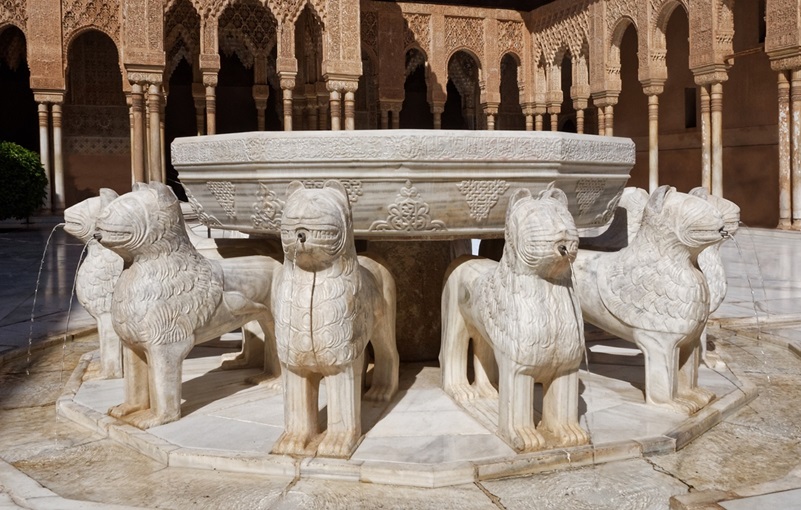
12 faceless lions spitting water at the Courtyard of the Lions • Travel Granada Alhambra
The Hall of the Kings is located in the east of the palace. This part of the palace was originally used for receptions. The locality received its name due to a painting on the walls that depicts the first ten kings of the Nasrid dynasty. The domes and the archways are endued with beautiful mocarabes – the typical stalactite-like ornaments that can be seen in many parts of the Nasrid Palaces.
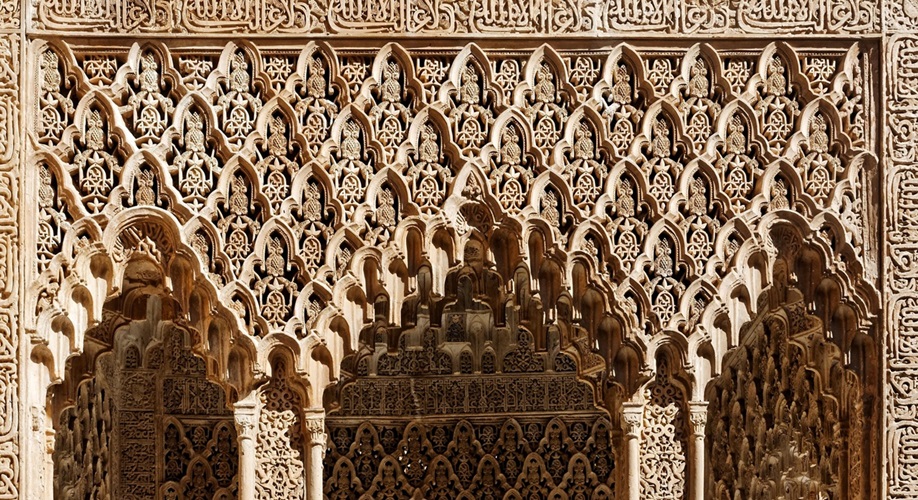
Mocarabes – Stalactite-like ornaments that can be seen everywhere in the Nasrid palaces • Travel Granada Alhambra
The Harem and the Hall of the Abencerrajes can be found in the southern part of the palace. While the harem was the sultan’s most private area where he amused himself with his four wives, the Hall of the Abencerrajes is shrouded in bloodthirsty legends. Arab folklore has it that Sultan Moulay Hacen ordered the killing of a group of Abencerrajes knights in this hall out of jealousy since there had been (false) rumors about one of his wives having a love affair with one of the knights. The towering dome of the hall is nothing but spectacular, forming an 8-pointed star fragmented into a field of mocarabesque ornaments.
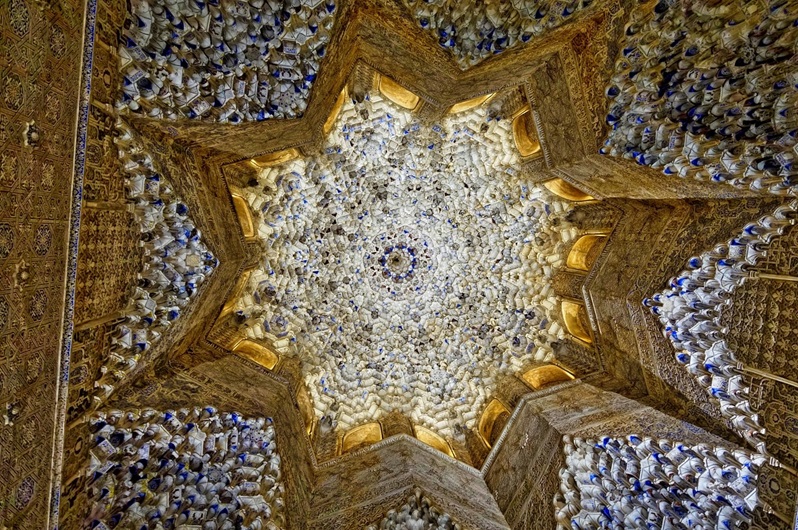
The awe-inspiring dome of the Hall of the Two Sisters • Travel Granada Alhambra
The Hall of the Two Sisters, the Hall of the Ajimeces and Daraxa’s Mirador are situated in the eastern wing of the palace. Two huge flagstones of Almeria marble that are set into the floor and which flank the fountain in this room have given the Hall of the Two Sisters its familial name. The dome of this hall is another stunning example of Muslim architecture as an intricate setting of light plays around the stunning arrangement of the ornate dome that is shaped like an open flower. One of the royal courts three poets, Ibn Zamrak, has left his poems on the walls here, in beautiful calligraphic writing, praising God, the sultan and the beauty of the arts.
d) The Partal
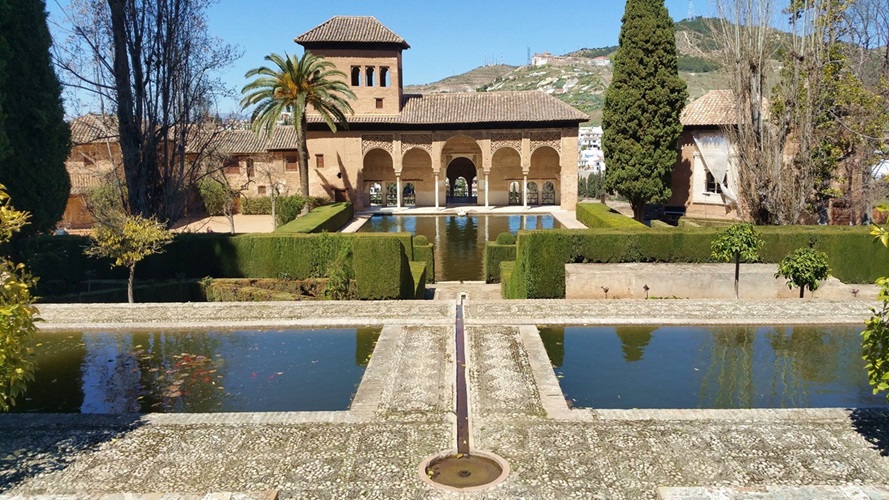
The Palace of the Partal with its beautiful pools • Travel Granada Alhambra
The Partal Palace (point 31) east of the Nasrid Palaces creates a welcome feeling of spaciousness. After having spent quite some time within the enclosed spaces of the Nasrid Palaces it is pleasant to breath the fresh air of the Andalusian mountains and to stroll around the blossoming trees and flowers of the surrounding gardens again. The Partal Palace itself is an open structure with a portico of five arches which allows you to overlook the melancholic Albayzin and Sacramonte neighborhoods to the north. The clever layout of two ponds on two different levels increases the sense of expanse even further.
Tip: Walk up to the archaeological site of Yusuf III’s Palace (point 33) and use it as a viewpoint. Make sure to stand perfectly in line with the two pools and the central arch of the Partal Palace in the background for the perfect picture!
e) Palace of Charles V
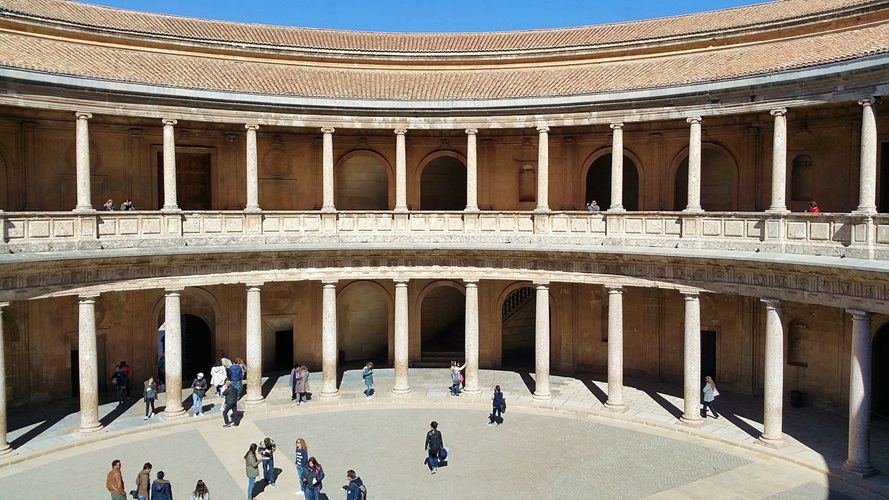
Inner courtyard of the Palace of Charles V • Travel Granada Alhambra
Palacio de Carlos V is the odd one out among all the palaces of the Alhambra. Commissioned by Charles V, ruler of both the Spanish and the Holy Roman Empire from 1519-1556, architect Pedro Machuca started building the Renaissance style structure in 1527. Unembellished and plain in appearance the edifice stands in stark contrast to the sumptuous obsession with details of the Nasrid Palaces. With its enormous inner courtyard which is encircled by a series of chaste pillars on two levels, the Palace of Charles V was a rather unusual architectural endeavor during a time when Plateresque architecture was the latest craze in Spain.
Interestingly enough, the main reason for Charles V to build a new palace back then was that he felt that the Arab palaces were not remotely befitting an Emperor of his stature. Ironically, time can play macabre tricks on those who tempt it. The construction of the monumental palace dragged on and on forever, and neither Charles V nor any other monarch would ever call it home. The palace was never completed and stood roofless until 1957. A testimony to the megalomania of men.
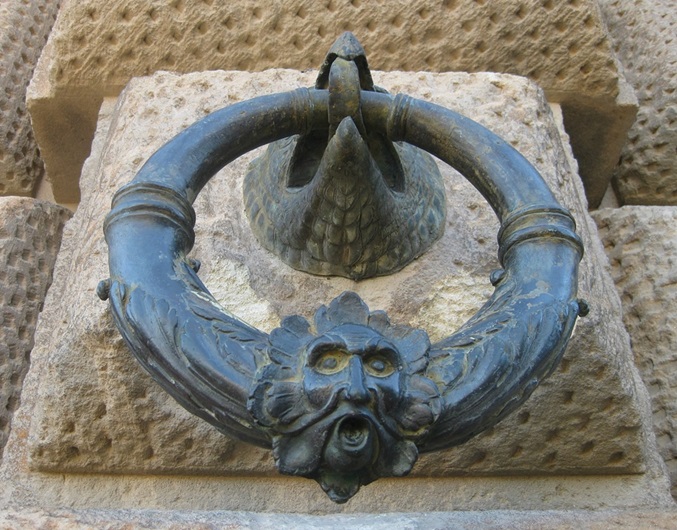
Ornamental iron rings girdle the facade of Palacio Carlos V, strong enough to keep Daenerys Targaryen’s dragons in check • Travel Granada Alhambra
